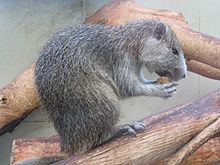| Hystricognathi Temporal range:
| |
|---|---|

| |
| Capromys pilorides | |
| Scientific classification | |
| Domain: | Eukaryota |
| Kingdom: | Animalia |
| Phylum: | Chordata |
| Class: | Mammalia |
| Order: | Rodentia |
| Suborder: | Hystricomorpha |
| Infraorder: | Hystricognathi Tullberg, 1899 |
| Families | |
|
Abrocomidae | |
| Synonyms | |
|
Eucaviomorpha | |
The Hystricognathi are an infraorder of rodents, distinguished from other rodents by the bone structure of their skulls. The masseter medialis (a jaw muscle) passes partially through a hole below each eye socket (called the infraorbital foramen) and connects to the bone on the opposite side. This, together with their lack of an infraorbital plate and the relative size of the infraorbital foramen, distinguishes hystricognaths from other rodent groups.
The 18 families within the Hystricognathi are divided into two parvorders, the Phiomorpha and the Caviomorpha. The Caviomorpha are mostly native to South America, with a few species in the Caribbean and North America, while the Phiomorpha occur in the Old World.
